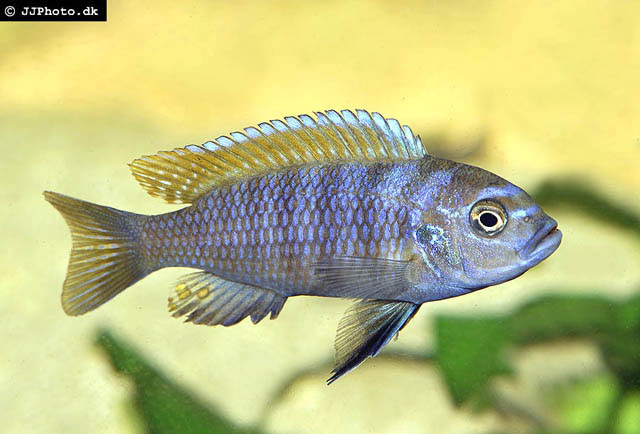| Cichlidae (Cichlids), subfamily: Pseudocrenilabrinae |
| 8.64 cm SL (male/unsexed) |
|
demersal; freshwater, |
| Africa: Lake Malawi in Malawi (Ref. 27596). |
|
Dorsal spines (total): 13-18; Dorsal soft rays (total): 8-10; Anal spines: 3-3; Anal soft rays: 6-9. Diagnosis: The moderately sloped head, swollen rostral tip of the neurocranium, isognathous jaws, and the presence of bicuspid teeth in the outer rows of the jaws place this species in Maylandia (Ref. 27596). The red dorsal fin in combination with black bars on a blue ground colour distinguish this species from all other members of the genus except for Maylandia emmiltos, which also has a red dorsal fin; Maylandia pyrsonotos differs from all the other red top BB forms in that the vertical black lateral bars infiltrate the proximal portion of the dorsal fin (Ref. 27596).
Description: Jaws isognathous; teeth on jaws in 2-4 rows; majority of teeth in outer rows bicuspid, with a few posterior unicuspid teeth; those in inner rows tricuspid; 4-13 teeth in outer row of left lower jaw (Ref. 27596, 76849). Dorsal fin with 16-18 spines; dorsal-fin rays 8-10; pectoral fins with 12-17 rays; anal fin with 3 spines and 6-8 rays (Ref. 27596). Lower pharyngeal bone triangular in outline (Ref. 27596). Scales along side ctenoid; 29-32 lateral-line scales; 0-2 pored scales post lateral line; 3-5 scale rows on cheek (Ref. 27596, 76849). First gill arch with 8-14 rakers on the ceratobranchial, 2-3 on epibranchial, and 1 between the epibranchial and ceratobranchial (Ref. 27596).
Colouration: Breeding males have a light blue ground colourartion laterally with 5-6 black vertical bars anterior to the caudal peduncle; belly black fading to light blue posteriorly; head black with 2 light interorbital bars; dorsal fin red/orange with vertical lateral bars of side sometimes penetrating the fin; light blue lappets; caudal fin blue with sometimes an orange cast; anal fin blue with 1-4 yellow ocelli; pelvic fins black with white leading edges (Ref. 27596). Females blue/gray laterally with faint barring; sometimes almost entirely black; head black with gray interorbital bars; dorsal fin with brown cast; anal fin and pelvic fins black (Ref. 27596). |
| Found at rocky shores (Ref. 27596). |
|
Least Concern (LC); Date assessed: 22 June 2018 Ref. (130435)
|
| harmless |
Source and more info: www.fishbase.org. For personal, classroom, and other internal use only. Not for publication.

